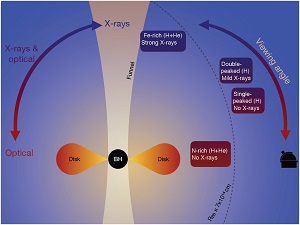A detailed spectroscopic study of tidal disruption events
- Details
- Published on 01 March 2022
Vol. 659
4. Extragalactic astronomy
A detailed spectroscopic study of tidal disruption events

Tidal disruption events (TDEs) occur when a star orbits too close to a supermassive black hole being ripped apart. Charalampopoulos and collaborators provide here one of the first UV-optical spectroscopic studies on a set of 16 tidal disruption events, with multi-epoch observations. Capitalizing on previous studies, they classify the events into two main categories, with H and He emission lines and with H (only) lines. Both of these classes can then be subdivided in two: H+He TDE can be Iron-rich or Nitogren-rich; and H TDE can be double-peaked or plain. Then, they connect these properties to X-ray emission, finding that only H+He Iron-rich and H-only with double-peaked lines show X-ray emission. As a final step, they envisage a possible viewing angle dependence for the observed spectroscopic and photometric properties of TDEs (see illustration).


